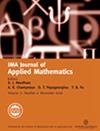The impact of confinement on the deformation of an elastic particle under axisymmetric tube flow
IF 1.2
4区 数学
Q2 MATHEMATICS, APPLIED
引用次数: 0
Abstract
We study an elastic particle translating axially along the centre-line of a rigid cylindrical tube filled with a Newtonian viscous fluid. The flow is pressure-driven and an axial body force is applied to the particle. We consider the regime in which the ratio of typical viscous fluid stress to elastic stiffness is small, leading to small elastic strains in the particle. In this case, there is a one-way decoupling of the fluid-structure interaction problem. The leading-order fluid problem is shown to be pressure-driven Stokes flow past a rigid sphere, and is solved using the semi-analytical method of reflections. The traction exerted by the fluid on the particle can be computed and used to formulate a pure solid-mechanics problem for the deformation of the particle, which can be solved analytically. This framework is used to investigate the role of the background flow, an axial body force, and the tube wall on the particle’s leading-order translational velocity, resulting deformation, and induced solid stress. By considering the first-order fluid problem the next-order correction to the translational velocity of the particle is shown to be zero. Depending on the magnitude of the ratio of applied body force to viscous forces, the particle can either have a bullet-like shape, an anti-bullet shape, or retain its original spherical shape. A non-linear arbitrary Lagrangian-Eulerian finite element implementation is used, in conjunction with various existing results from the literature, to validate the method of reflections solutions and interrogate their range of validity.封闭对轴对称管流条件下弹性粒子变形的影响
我们研究了一个沿充满牛顿粘性流体的刚性圆柱管中心线轴向平移的弹性粒子。流动由压力驱动,粒子受到轴向体力的作用。我们考虑的情况是,典型粘性流体应力与弹性刚度之比很小,从而导致粒子产生很小的弹性应变。在这种情况下,流固耦合问题是单向的。前序流体问题被证明是经过刚性球体的压力驱动斯托克斯流,并使用半解析反射法求解。流体对颗粒施加的牵引力可以计算出来,并用于制定颗粒变形的纯固体力学问题,该问题可以分析求解。该框架用于研究背景流、轴向体力和管壁对粒子前阶平移速度、产生的变形和诱导固体应力的作用。通过考虑一阶流体问题,粒子平移速度的下一阶修正为零。根据外加体力与粘性力之比的大小,质点可以是子弹状,也可以是反子弹状,或者保持原来的球形。使用非线性任意拉格朗日-欧拉有限元实现,结合文献中的各种现有结果,验证了反射解法,并询问了其有效性范围。
本文章由计算机程序翻译,如有差异,请以英文原文为准。
求助全文
约1分钟内获得全文
求助全文
来源期刊
CiteScore
2.30
自引率
8.30%
发文量
32
审稿时长
24 months
期刊介绍:
The IMA Journal of Applied Mathematics is a direct successor of the Journal of the Institute of Mathematics and its Applications which was started in 1965. It is an interdisciplinary journal that publishes research on mathematics arising in the physical sciences and engineering as well as suitable articles in the life sciences, social sciences, and finance. Submissions should address interesting and challenging mathematical problems arising in applications. A good balance between the development of the application(s) and the analysis is expected. Papers that either use established methods to address solved problems or that present analysis in the absence of applications will not be considered.
The journal welcomes submissions in many research areas. Examples are: continuum mechanics materials science and elasticity, including boundary layer theory, combustion, complex flows and soft matter, electrohydrodynamics and magnetohydrodynamics, geophysical flows, granular flows, interfacial and free surface flows, vortex dynamics; elasticity theory; linear and nonlinear wave propagation, nonlinear optics and photonics; inverse problems; applied dynamical systems and nonlinear systems; mathematical physics; stochastic differential equations and stochastic dynamics; network science; industrial applications.

 求助内容:
求助内容: 应助结果提醒方式:
应助结果提醒方式:


